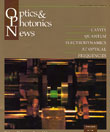
August 1992 Issue
Feature Articles
Volume Hologram Optical Memories: Mass Storage Future Perfect?
The world's appetite for high-performance mass storage grows exponentially. Today's advanced computing systems are only marginally served by existing mass storage products, despite the remarkable advances in the 1980s of magnetic, optical, and semiconductor devices. Hence, great interest is focused on beam-addressable and wavelength or frequency-selectable optical memories that simultaneously provide very large capacities, fast random access, and very high I/O rates. Like never being too thin or too rich, one can never have enough storage. Over the years, a consistent refrain has been that the demand for storage would moderate and the capabilities of semiconductor and magnetic storage technologies would soon reach their limits. Yet during the past decade, demand for storage has had an average annual growth rate of over 30%; the price/performance of every type of memory has improved remarkably and is still doing so at a phenomenal pace.
by Richard G. ZechInternational Standards for Ophthalmic Optics and EC '92
European economic unification— known as EC '92—has had a major effect on the pace and organization of the standardization effort in ophthalmic optics. Initially, the creation of standards for ophthalmic optics proceeded at a studied pace. Standard writing is not a naturally rapid process and, while steady progress was made during the first five years, the production of standards was fairly low.
by Charles CampbellLooking into Mirrors
Although we look into mirrors every day, there are many interesting aspects about mirrors that might seem surprising to both youngsters and adults. Here we will investigate the answers to three interesting questions: When you look at yourself in a mirror, where are you really looking? How much of yourself can you see in a mirror, and does the amount depend on how far away you are? Does a mirror really left-right reverse letters placed in front of it?
by Fred GoldbergCavity Quantum Electrodynamics At Optical Frequencies
Quantum electrodynamics (QED) tells us that the electromagnetic field is, on a mode-by-mode basis, quantized according to the harmonic oscillator model. Each mode is ascribed a lowest energy (or dark) state possessing one half quanta of non-removable energy plus an infinite ladder of equally spaced excited states accessed through the addition or removal of energy quanta from the mode. In the optical regime and under normal thermal conditions, electromagnetic field modes are typically in their dark state. Nevertheless, a residual dark-state atom-field coupling remains, and it is this coupling that mediates shifts and spontaneous radiative decay of atomic states. The experimental reality of dark-state atom-field coupling is frequently interpreted as proof of the quantum description of light.
by Steven E. Morin, Qilin Wu, and Thomas W. Mossberg

![A multiplexed image of a human tonsil acquired. [NIAID] using the iterative bleaching extends multiplexity (IBEX) method.](https://opnmedia.blob.core.windows.net/$web/opn/media/images/articles/2024/0424/departments/202404-cover-web.jpg?ext=.jpg)
